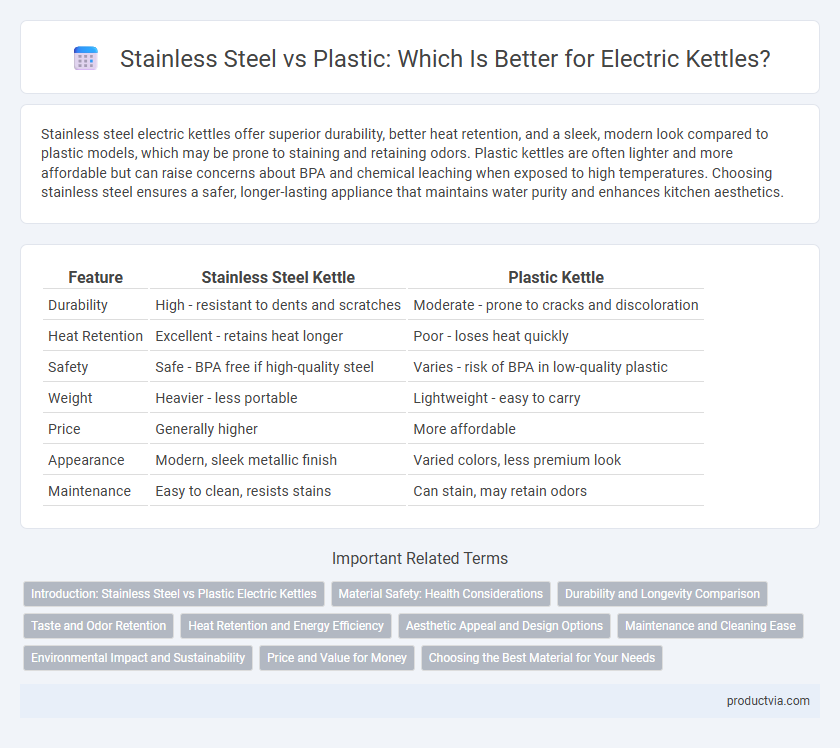Stainless steel electric kettles offer superior durability, better heat retention, and a sleek, modern look compared to plastic models, which may be prone to staining and retaining odors. Plastic kettles are often lighter and more affordable but can raise concerns about BPA and chemical leaching when exposed to high temperatures. Choosing stainless steel ensures a safer, longer-lasting appliance that maintains water purity and enhances kitchen aesthetics.
Table of Comparison
| Feature | Stainless Steel Kettle | Plastic Kettle |
|---|---|---|
| Durability | High - resistant to dents and scratches | Moderate - prone to cracks and discoloration |
| Heat Retention | Excellent - retains heat longer | Poor - loses heat quickly |
| Safety | Safe - BPA free if high-quality steel | Varies - risk of BPA in low-quality plastic |
| Weight | Heavier - less portable | Lightweight - easy to carry |
| Price | Generally higher | More affordable |
| Appearance | Modern, sleek metallic finish | Varied colors, less premium look |
| Maintenance | Easy to clean, resists stains | Can stain, may retain odors |
Introduction: Stainless Steel vs Plastic Electric Kettles
Stainless steel electric kettles offer enhanced durability, heat retention, and a sleek, modern appearance compared to plastic models. Plastic kettles are generally lighter and more affordable but may absorb odors and discolor over time. Choosing between stainless steel and plastic depends on factors like longevity, taste preservation, and budget preferences.
Material Safety: Health Considerations
Stainless steel electric kettles offer superior material safety due to their resistance to corrosion and absence of harmful chemicals like BPA, which can leach from plastic kettles when exposed to boiling water. Plastic kettles often contain additives that may pose health risks over time, especially with repeated heating. Choosing a stainless steel kettle reduces the risk of chemical contamination, ensuring safer boiling and better water taste.
Durability and Longevity Comparison
Stainless steel electric kettles offer superior durability due to their resistance to dents, scratches, and high temperatures, often lasting upwards of 5 to 10 years with proper care. Plastic kettles, while more affordable and lightweight, tend to degrade over time as heat exposure can cause brittleness, discoloration, and potential cracking within 2 to 4 years. Choosing stainless steel enhances longevity and reduces the need for frequent replacements, making it a more cost-effective material for long-term use.
Taste and Odor Retention
Stainless steel electric kettles have superior taste and odor retention properties, preventing the absorption of flavors and resistant to lingering smells, ensuring pure water taste every time. Plastic kettles can sometimes impart a slight taste or odor, especially if made from lower-quality materials or after prolonged use. Choosing stainless steel enhances the overall drinking experience by maintaining water purity and minimizing residual odors.
Heat Retention and Energy Efficiency
Stainless steel electric kettles excel in heat retention due to the metal's superior insulating properties, allowing water to stay hot longer compared to plastic models. This enhanced heat retention contributes to improved energy efficiency by reducing the frequency of reheating. Plastic kettles, while lighter and often cheaper, generally lose heat faster, leading to increased energy consumption over time.
Aesthetic Appeal and Design Options
Stainless steel electric kettles offer a sleek, modern aesthetic with a polished finish that complements contemporary kitchen designs, while plastic kettles provide a wider variety of colors and shapes, catering to more diverse personal styles. The metallic sheen of stainless steel enhances durability and lends a premium look, whereas plastic models can feature translucent water windows and ergonomic designs that emphasize practicality and customization. Choosing between stainless steel and plastic impacts both the visual appeal and integration with kitchen decor, balancing elegance with versatility.
Maintenance and Cleaning Ease
Stainless steel electric kettles offer superior durability and resist staining, making them easier to clean and maintain without retaining odors or flavors. Plastic kettles may develop scratches and discoloration over time, which can harbor bacteria and require more frequent cleaning to ensure hygiene. Regular descaling with vinegar or citric acid is essential for both materials, but stainless steel kettles generally withstand harsh cleaning agents better.
Environmental Impact and Sustainability
Stainless steel electric kettles offer superior environmental benefits due to their durability and recyclability, significantly reducing waste over time compared to plastic models. Plastic kettles often contain BPA and other chemicals that can leach into water, contributing to environmental pollution and posing health risks. Choosing a stainless steel option supports sustainability by minimizing plastic waste and promoting a longer product lifecycle.
Price and Value for Money
Stainless steel electric kettles generally have a higher upfront cost but offer superior durability and better heat retention, making them a long-term value for money investment. Plastic kettles are more budget-friendly and lightweight, but they may wear out faster and can impart a plastic taste to the water. Choosing between the two depends on balancing initial price sensitivity with desired longevity and overall performance.
Choosing the Best Material for Your Needs
Stainless steel electric kettles offer durability, heat retention, and a sleek aesthetic, making them ideal for long-term use and frequent boiling. Plastic kettles are lightweight, budget-friendly, and often feature transparent water level indicators, but may absorb odors and discolor over time. Selecting between stainless steel and plastic depends on priorities such as longevity, heat retention, safety, and ease of cleaning.
Stainless steel vs plastic for electric kettle Infographic

 productvia.com
productvia.com